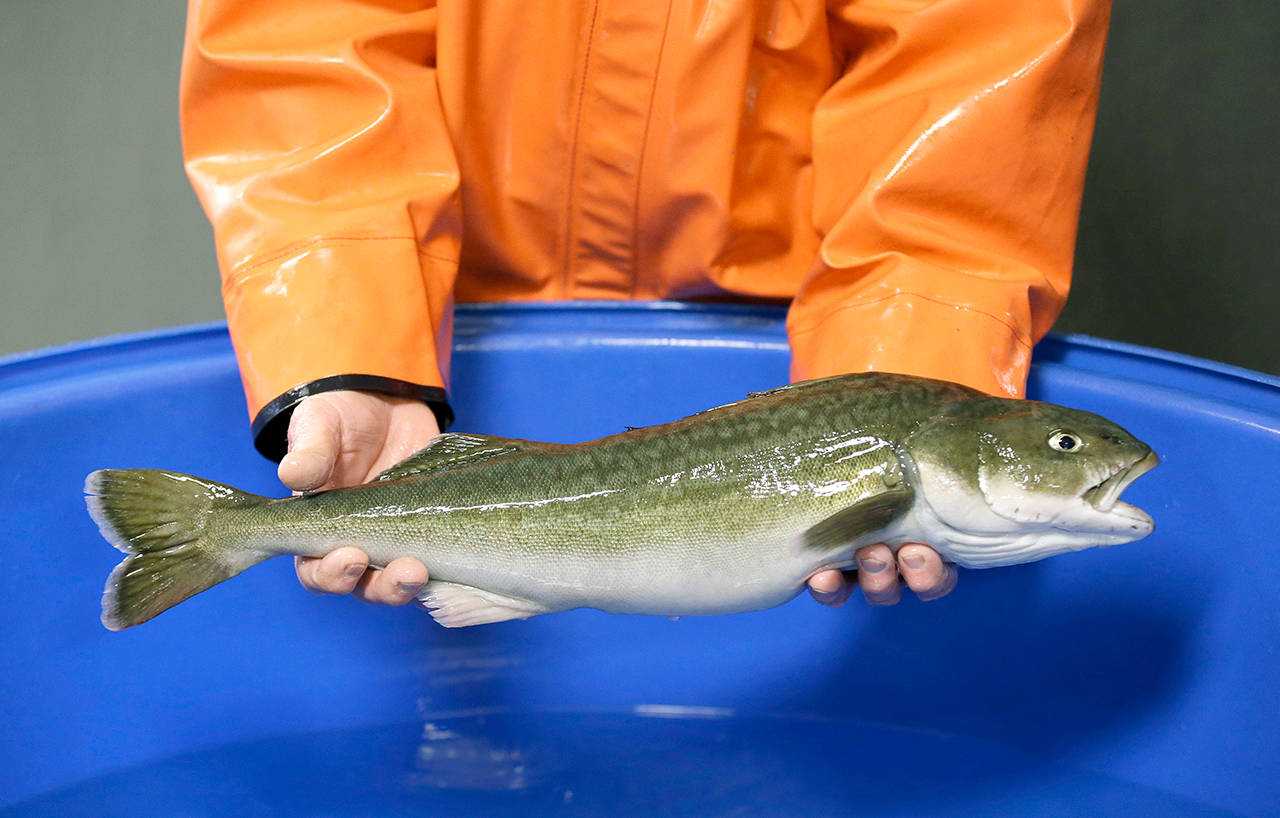By Phuong Le, Associated Press
PORT ORCHARD — The dark gray fish prized for its buttery flavor live deep in the ocean, so researchers keep their lab cold and dark to simulate ideal conditions for sablefish larvae.
A biologist shines his dim red headlamp and uses an ultrasound to scan the belly of an anesthetized sablefish about the length of his forearm to tell if it’s female and has eggs to collect. He gently squeezes out hundreds of tiny, translucent eggs into a glass beaker.
After the eggs are fertilized externally, they’ll grow in large indoor tanks and some in floating net pens in Washington state’s Puget Sound to be used for research.
At this federal marine research station near Seattle, scientists are studying sablefish genetics and investigating ways to make it easier and more efficient to commercially grow the fish.
It is part of a larger effort by the National Oceanic and Atmospheric Administration to support marine aquaculture as a solution to feed a growing demand worldwide for seafood.
People are consuming more fish than in previous decades, with average worldwide per capita consumption hitting 43 pounds (20 kilograms) a year, according to the Food and Agriculture Organization of the United Nations. Fish consumption is expected to grow even more in coming years.
NOAA says aquaculture can relieve pressure on fishing populations and promote economic growth.
Fishermen along the U.S. West Coast, mostly in Alaska, catch millions of pounds of wild sablefish each year but no commercial sablefish net-pen farming exists in the U.S.
Sablefish, also known as black cod or butterfish, are long-lived species that is native to the northeast Pacific Ocean and highly valued in Asia for its beneficial nutrients and delicate flavor. The fish are grilled, smoked, poached, roasted or served as sushi.
Michael Rubino, who directs the NOAA aquaculture program, noted that practices for farming fish in the U.S. meet very strict environmental regulations.
But some critics worry large-scale farms could harm wild fish stocks and ocean health, and some commercial fishermen worry about potential competition.
“This would be a big threat for us,” said Robert Alverson, executive director of the Fishing Vessel Owners’ Association, a Seattle-based group that represents about 95 commercial fishermen in Alaska, Oregon, Washington and California.
In 2015, fisherman harvested about 35 million pounds (16 million kilograms) of sablefish worth $113 million in the United States, all along the U.S. West Coast.
Of that, nearly two-thirds, or about 23 million pounds (10 million kilograms), were caught in Alaska, with smaller amounts in Oregon, Washington and California. Nearly half of the sablefish caught in the United States is exported, with a majority going to Japan.
“Our fear is that science isn’t going to stay in the U.S., and it will be exported to a Third World country where people work for a few bucks a day,” Alverson said. “They’ll raise it with low-valued labor and use our science to undercut our commercial fishery and coastal communities.”
Alaska law prohibits finfish farming.
Rubino and others say wild harvests and aquaculture can complement each other, particularly during months when there are lower catch limits for wild sablefish.
“You always have this yin-yang problem between fisheries and aquaculture,” Rick Goetz, who leads the marine fish and shellfish biology program at the Manchester Research Station, across Puget Sound from Seattle. “The big problem is allaying the fears of people that you can have both. You can have both of those things working, particularly because this fish is such a high-value product.”
In recent years, NOAA Fisheries scientists have worked to reduce potential barriers to sablefish aquaculture. They have developed techniques to produce all-female stocks of sablefish that grow faster and much bigger than males in about 24 months. Ideal market size is roughly 5 ½ pounds (2 ½ kilograms).
They’ve also studied different ways to reduce the costs of feeding juvenile fish, increase larvae survival rates and decrease deformities.
One research project is replacing more expensive algae with clay that is used to help sablefish larvae better find their prey. Another looked at finding the optimal temperature to increase larval growth.
Wild fish are caught off the Washington coast and used to develop captive brood stocks, or mature fish that are used for breeding.
At the facility, the fertilized eggs grow in silos in dark, cold rooms before being moved to other indoor tanks where they’re fed a steady diet of brined shrimp and other food. Large circular tanks hold fish in different growth stages.
The facility produces about 10,000 all-female fingerlings, or juveniles about an inch (25 millimeters) long, each year.
It has sent some fish to a Texas company that uses land-based recirculation tanks to grow fish, as well as others interested in sablefish aquaculture.
NOAA Fisheries also is working with a Native American tribe in Washington state to get a pilot project to grow sablefish in net pens outside the research facility at Manchester. The tribe and others have applied for a federal grant.
Kurt Grinnell, aquaculture manager for the Jamestown S’Kallam Tribe, said the tribe is very interested in sablefish aquaculture for many reasons.
“It’s a native fish to our area. It’s a very robust fish. It’s very sought-after. It’s got great market value,” he said. “Over time, our country and other countries will have to get their protein source somewhere, and we believe this is one way to meet that demand.”
Talk to us
> Give us your news tips.
> Send us a letter to the editor.
> More Herald contact information.

























